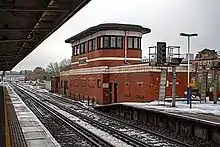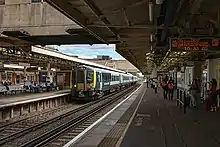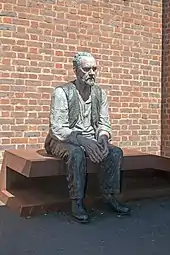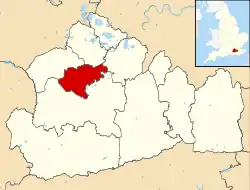Woking railway station
Woking railway station is a major stop in Woking, England, on the South West Main Line used by many commuters. It is 24 miles 27 chains (39.2 km) down the line from London Waterloo. The station is managed by South Western Railway, who operate all trains serving it.
Woking | |
|---|---|
 | |
| General information | |
| Location | Woking England |
| Coordinates | 51°19′05″N 0°33′25″W |
| Grid reference | TQ006587 |
| Managed by | South Western Railway |
| Platforms | 6 |
| Other information | |
| Station code | WOK |
| Classification | DfT category B |
| History | |
| Original company | London and Southampton Railway |
| Pre-grouping | London and South Western Railway |
| Post-grouping | Southern Railway |
| Key dates | |
| 21 May 1838 | Station opened as Woking Common |
| c. 1843 | Renamed Woking |
| Passengers | |
| 2017/18 | |
| Interchange | |
| 2018/19 | |
| Interchange | |
| 2019/20 | |
| Interchange | |
| 2020/21 | |
| Interchange | |
| 2021/22 | |
| Interchange | |
| Notes | |
Passenger statistics from the Office of Rail and Road | |
History

The London and Southampton Railway (L&SR) was authorised on 25 July 1834[3][note 1] and construction began in October of that year.[5] The line was built in stages, and the first section, between the London terminus at Nine Elms and "Woking Common", was opened to passengers on 21 May 1838.[6][note 2] Woking Common station was built with two platforms linked by a footbridge and a small freight yard was also provided. When it opened, it was surrounded by open heath[8] and was 2 km (1.2 mi) from what is now the village of Old Woking.[9] Nevertheless, it quickly became the railhead for west Surrey and the main entrance was positioned on the south side of the tracks for the convenience of those travelling by stagecoach from Guildford. Construction of Woking town centre, to the north of the station, did not begin until the mid-1860s.[10]
Woking Common became a through station on 24 September 1838, with the opening of the next section of the line as far as Winchfield.[11][12] The station was given its current name of "Woking" in around 1843.[13] The Guildford Junction Railway (GJR) opened on 5 May 1845,[14] having been authorised less than a year earlier, on 10 May 1844.[15] The GJR was always operated by the LSWR, and was absorbed by that company on 4 August 1845.[16]
The track through Woking station was quadrupled in 1904 and electrified in 1937.[17] The station was rebuilt by the Southern Railway in the Art Deco "Odeon" style in 1936–37. The signal box, which was constructed as part of the rebuilding programme, is a Grade II listed building.[2][1][18]
Accidents and incidents
Three trains were involved in a collision just east of the station on 23 December 1955. A Portsmouth line electric train came to a stand at signals near the Maybury Hill Road bridge. The following steam-hauled Waterloo-Basingstoke train overran the Maybury distant signal and collided with the rear of the electric train, demolishing the guards compartment and deflecting the rear bogie so that it was foul of the up-line. An up Bournemouth steam-hauled train had just left the station and came into sidelong collision with the bogie and came to a stand. Out of around 1000 passengers and crew on the three trains only 21 were injured, including the guard of the electric train, and there were no fatalities. The Ministry of Transport and Civil Aviation report concluded the crash was due to human error on the part of the driver of the Basingstoke train.[19][20] The Basingstoke train locomotive, SR N15X class 32327 Trevithick, was damaged beyond economic repair and scrapped at Eastleigh Works.[21]
Services
Passenger
Many South Western Railway services call at Woking, including:
- the Alton Line calling at stations to Alton
- the Portsmouth Direct Line to Guildford and stations to Portsmouth
- the South West Main Line to Winchester, Southampton, Bournemouth, Poole and Weymouth
- the West of England Main Line to Andover, Salisbury and Exeter
- The station is a terminus of the Waterloo to Woking stopping service
Fast trains from Woking take approximately 26 minutes to reach London Waterloo (some stop at Clapham Junction). Trains from the Alton Line take roughly 35 minutes, and the stopping service 50 minutes, to Waterloo.
A half-hourly RailAir bus service runs between the south side of the station and Heathrow Airport, a journey of about 50 minutes.[22]
As of December 2022, the off-peak Monday to Saturday services are as follows:
- 12 tph to London Waterloo (2 of these are stopping services, 2 of such stop only at Clapham Junction, 4 of which are semi fast and the remaining 4 are non-stop)
- 2 tph to Alton (semi-fast)
- 1 tph to Weymouth via Bournemouth (fast)
- 1 tph to Haslemere via Godalming (stopping)
- 2 tph to Basingstoke (stopping)
- 2 tph to Portsmouth Harbour via Guildford (1 fast, 1 stopping)
- 1 tph to Portsmouth Harbour via Eastleigh (stopping)
- 1 tph to Exeter St Davids via Salisbury

| Preceding station | Following station | |||
|---|---|---|---|---|
| Clapham Junction or London Waterloo |
South Western Railway Portsmouth Direct Line |
Guildford | ||
| South Western Railway Portsmouth Direct Line (Stopping service) |
Worplesdon | |||
| South Western Railway South West Main Line |
Farnborough (Main) or Basingstoke or Winchester | |||
| South Western Railway West of England Main Line |
Basingstoke | |||
| West Byfleet | South Western Railway Alton Line |
Brookwood | ||
| South Western Railway Waterloo to Woking (Stopping service) |
Terminus | |||
| Weybridge | South Western Railway Waterloo to Basingstoke (Stopping service) |
Brookwood | ||
| Historical railways | ||||
| Staines | Anglia Railways London Crosslink |
Farnborough (Main) | ||
Platform layout
Woking station | ||||||||||||||||||||||||||||||||||||||||||||||||||||||||
|---|---|---|---|---|---|---|---|---|---|---|---|---|---|---|---|---|---|---|---|---|---|---|---|---|---|---|---|---|---|---|---|---|---|---|---|---|---|---|---|---|---|---|---|---|---|---|---|---|---|---|---|---|---|---|---|---|
| ||||||||||||||||||||||||||||||||||||||||||||||||||||||||
Woking Station has six platforms, two of which are bay platforms.
- Platform 1 – Semi-fast London-bound services.
- Platform 2 – Fast London-bound services. Part of a single island with 3 and 4 below.
- Platform 3 – East-facing bay for stopping service to and from London Waterloo. At the end of platforms 2 and 4.
- Platform 4 – Trains to Exeter St Davids, Portsmouth Harbour (via Basingstoke), Salisbury and Weymouth.
- Platform 5 – Portsmouth Direct Line services, Alton line and Basingstoke stopping services.
- Platform 6 – West-facing bay platform, used by the first train of the day to Portsmouth Harbour via Eastleigh, and often used to stable trains in the event of a train failure.
Freight
Woking still retains two sets of sidings, each to the west of the station. The down side yard, between the station and Woking junction, is now a Network Rail permanent way maintenance depot[23] and aggregates stone depot operated by Day Aggregates.[24] The up side sidings are used to stable specialist track maintenance machines and out of service passenger trains.
In popular culture

- The station was destroyed in H. G. Wells's The War of the Worlds.[26]
- Woking Station can be seen at the beginning of the 1995 music video for 'You Do Something To Me' by Paul Weller.[27]
- In the television adaptation of the Philip K. Dick story "The Commuter" for the series Philip K. Dick's Electric Dreams, railway worker Ed Jacobson (played by Timothy Spall) works at Woking station, and discovers a non-existent destination on the Alton line.[28]
- Seated Man, created in 2011 by the artist, Sean Henry, was installed on platform 1 in August 2017.[25][29]
Notes
- The L&SR was renamed the London and South Western Railway (LSWR) on 4 June 1839.[4]
- The formal opening of the line took place on 12 May 1838, when the company directors joined the first train from Nine Elms to Woking Common. The 46 mi (74 km) return trip took around 1 hour and 28 minutes.[7]
References
- Wakeford 2003, p. 35.
- Historic England. "Woking signal box (Grade II) (1236967)". National Heritage List for England. Retrieved 31 March 2019.
- Williams 1968, p. 20.
- Williams 1968, p. 122.
- Wakeford 1987, p. 26.
- Williams 1968, pp. 35–36.
- "Opening of the London And Southampton Railway". The Times. No. 4337. London. 14 May 1838.
- Wakeford 1987, pp. 43–44.
- Mitchell & Smith 1988, Fig. 1.
- Wakeford 1987, p. 75.
- Williams 1968, p. 38.
- Mitchell & Smith 1988, Introduction.
- Butt 1995, p. 253.
- Williams 1968, p. 132.
- Williams 1968, p. 126.
- Awdry 1990, p. 187.
- Mitchell & Smith 1986, p. 4.
- "Two Surrey stations to be rebuilt". The Times. No. 47173. London. 19 September 1935. p. 9.
- "Train crash's low injury toll a Christmas miracle". Woking News and Mail. Retrieved 27 June 2022.
- "Report on the Collision which occurred on 23rd December 1955 near Woking in the Southern Region British Railways" (PDF). Railways Archive. Retrieved 27 June 2022.
- Earnshaw 1991, p. 18.
- "Changes to RailAir 2 timetable from 20 August 2023". RailAir. Retrieved 23 September 2023.
- "Network Rail P-way Maintenance Depot". Nicelocal. Retrieved 27 June 2022.
- "Aggregate Wharves and Rail Depots in South East England" (PDF). Gov.UK. Retrieved 27 June 2022.
- "Woking statues become permanent fixture after council buys popular artwork". Surrey Live. 15 November 2017. Archived from the original on 27 November 2020. Retrieved 2 August 2020.
- Wells 1975, p. 59.
- Weller, Paul (9 October 2009). You Do Something To Me. YouTube. Retrieved 24 November 2022.
- McKeon, Christopher (29 September 2017). "Woking railway station is going to be on TV!". Get Surrey. Retrieved 13 October 2017.
- "Sean Henry sculpture gives Woking's commuters pause for thought". The Art Newspaper. 16 August 2017. Retrieved 24 November 2022.
Bibliography
- Awdry, Christopher (1990). Encyclopaedia of British Railway Companies. London: Guild Publishing. CN 8983.
- Butt, R.V.J. (1995). The Directory of Railway Stations. Yeovil: Patrick Stephens Ltd. ISBN 1-85260-508-1. R508.
- Earnshaw, Alan (1991). Trains in Trouble. Vol. 7. Penryn: Atlantic Books. ISBN 0-906899-50-8.
- Mitchell, Vic; Smith, Keith (1986). Waterloo to Woking. Midhurst: Middleton Press. ISBN 978-0-90-652038-3.
- Mitchell, Vic; Smith, Keith (1988). Woking to Southampton. Midhurst: Middleton Press. ISBN 978-0-90-652055-0.
- Wakeford, Iain (1987). Woking 150 : The history of Woking and its railway. Woking: Mayford & Woking District History Society. ISBN 978-0-95-026751-7.
- Wakeford, Iain (2003). Woking town centre : An illustrated history. Iain Wakeford.
- Wells, H.G. (1975) [1898]. The War of the Worlds. London: Pan Books. ISBN 0-330-24332-2.
- Williams, R.A. (1968). The London & South Western Railway, volume 1: The Formative Years. Newton Abbot: David & Charles. ISBN 0-7153-4188-X.
External links
- Train times and station information for Woking railway station from National Rail
